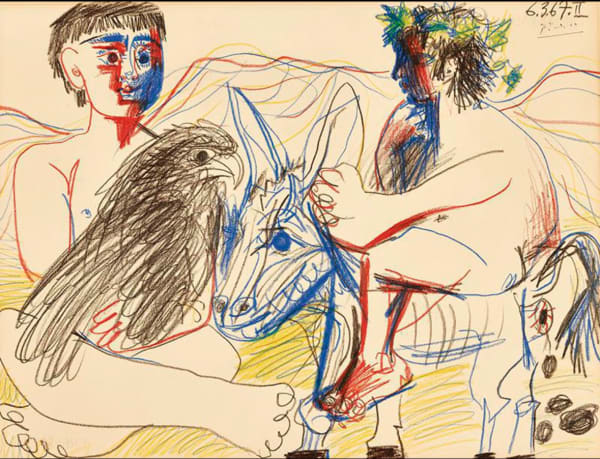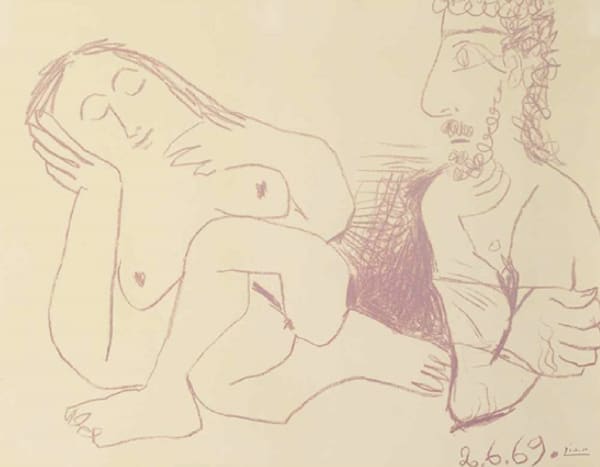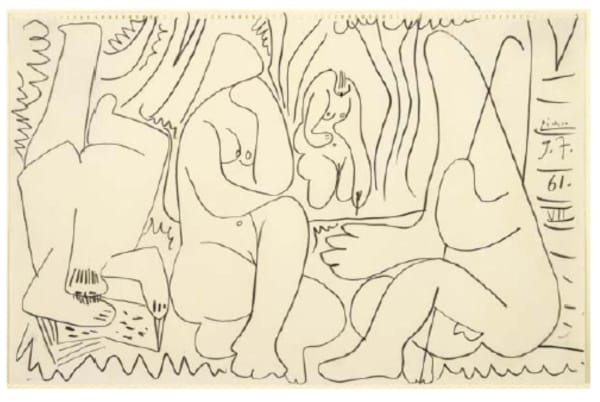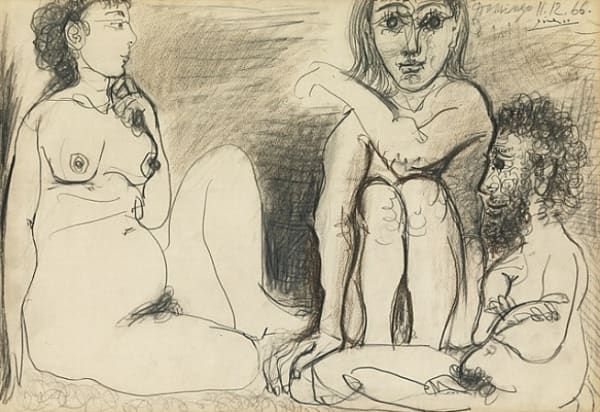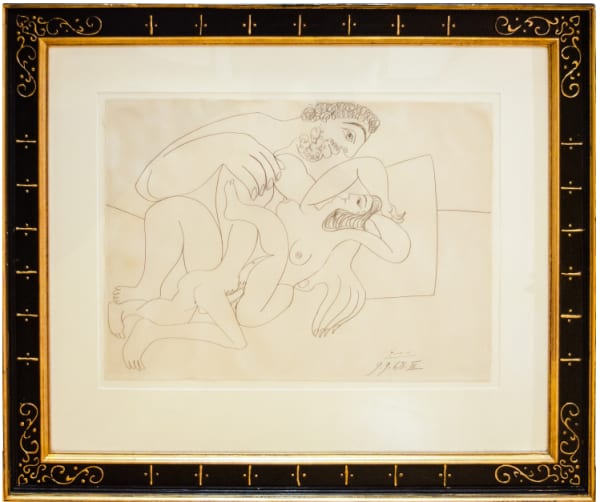
Pablo Picasso
Signed and dated
55 x 42 cm
In Toros (1961), Pablo Picasso returns to one of the most enduring symbols in his entire oeuvre: the bull. Executed in India ink and watercolour, this deceptively simple work fuses abstraction and figuration into a poetic tribute to the Spanish bullfight—a spectacle that captivated Picasso for most of his life. The fluidity of the ink wash, layered with pale brushstrokes to form crude, spectral figures, imbues the work with both immediacy and depth, conveying the raw, ritualistic power of the corrida.
The composition is minimal but highly expressive. A dynamic dark wash of black and grey covers most of the paper, serving as a dramatic stage upon which white, almost calligraphic forms emerge. These light marks sketch out a ghostly toreador on horseback, a seated spectator, and other undefined figures or movements, alluding to the drama of the arena. The word “TOROS” anchors the work at the center, printed over the dark wash like a poster or proclamation. Above it, energetic zigzag lines resemble the mountains or perhaps cheering crowds—ambiguous forms that reinforce the emotional texture rather than literal detail.
This work echoes the aesthetic freedom of Picasso’s late period, where he increasingly leaned into gestural, symbolic, and primal modes of representation. Here, we find a loose, painterly language akin to cave painting or ancient petroglyphs—stripped of fine detail but rich in archetypal power. The horse and bull become line and energy rather than anatomical form. This places the work closer in spirit to his ceramic experiments, his printmaking, and his 1940s Tauromaquia series.
The bull was more than a subject for Picasso—it was a recurring emblem of virility, power, violence, and death. A Spaniard in exile for most of his adult life, Picasso frequently returned to bullfighting as a nostalgic, mythic, and political motif. In Guernica (1937), the bull appears as a symbol of brutality and survival amid the horrors of war. In his drawings and prints, the bull often stands in for masculine force, instinct, and even the artist himself.
In Toros, however, the bull is not explicitly shown, but rather implied through the context and the figure of the horse-mounted picador. The absence of the bull sharpens the work’s atmospheric tension—it becomes more about the ritual and space of the bullfight than a literal retelling. The spectator and arena-like elements evoke the social and psychological theatre that surrounds violence and spectacle, inviting reflection rather than simply depiction.
By 1961, Picasso was 80 years old and entering one of his most prolific and expressive final decades. Far from slowing down, his late works display a remarkable synthesis of styles developed over a lifetime—Cubism, Surrealism, Neoclassicism, Expressionism—blended with childlike spontaneity and emotional directness. Toros reflects this freedom. It is not academic or detailed, but raw, immediate, and intensely personal. The inscription to Pierre Courthion, an art critic and close friend, adds a note of intimacy, positioning the work as both homage and artistic meditation.
Toros exemplifies Picasso’s unique ability to capture timeless themes with minimal means. It is not merely a scene of bullfighting, but a distilled essence of mythology, memory, and mortality—hallmarks of Picasso’s late genius.
For more information on Toros, contact our galleries via the inquiry form below.
-
 Pablo PicassoThe Foot Bath | Le Bain de pieds, 1960
Pablo PicassoThe Foot Bath | Le Bain de pieds, 1960 -
 Pablo PicassoFemme tenant un journal, 1915
Pablo PicassoFemme tenant un journal, 1915 -
 Pablo PicassoTrois Personnages,, 1954
Pablo PicassoTrois Personnages,, 1954 -
 Pablo PicassoQuatre têtes d’élégantes (Four Elegant Heads), c. 1899
Pablo PicassoQuatre têtes d’élégantes (Four Elegant Heads), c. 1899 -
 Pablo PicassoLes déjeuners,, 1961
Pablo PicassoLes déjeuners,, 1961 -
 Pablo PicassoTête de faune, 1958
Pablo PicassoTête de faune, 1958 -
 Pablo PicassoTeenager, eagle and donkey, 1967
Pablo PicassoTeenager, eagle and donkey, 1967 -
 Pablo PicassoTrois hommes et femme nus, 1967
Pablo PicassoTrois hommes et femme nus, 1967 -
 Pablo PicassoHomme Assis, 1971
Pablo PicassoHomme Assis, 1971 -
 Pablo PicassoBust of Naked Man and Woman, 1969
Pablo PicassoBust of Naked Man and Woman, 1969 -
 Pablo PicassoLe déjeuner, 1962
Pablo PicassoLe déjeuner, 1962 -
 Pablo PicassoLes déjeuners,, 1961
Pablo PicassoLes déjeuners,, 1961 -
 Pablo PicassoLes Dejeuners, 1961
Pablo PicassoLes Dejeuners, 1961 -
 Pablo PicassoTrois Personnages nus Assis, 1966
Pablo PicassoTrois Personnages nus Assis, 1966 -
 Pablo PicassoHomme et Femme, 1926
Pablo PicassoHomme et Femme, 1926 -
 Pablo PicassoL’Etreinte, 1968
Pablo PicassoL’Etreinte, 1968 -
 Pablo Picasso·Étude pour la Suite Des Déjeuners III, 1959
Pablo Picasso·Étude pour la Suite Des Déjeuners III, 1959
Join our mailing list
* denotes required fields
We will process the personal data you have supplied in accordance with our privacy policy (available on request). You can unsubscribe or change your preferences at any time by clicking the link in our emails.
This website uses cookies
This site uses cookies to help make it more useful to you. Find out more about cookies.






